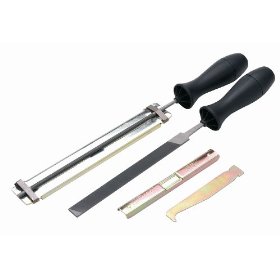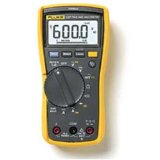


Search This Site
Search With Google
Chainsaw Sharpening
Moisture Meter Guide
The complete moisture meter website
As with all gardening power tools, the petrol chainsaw is no exception and requires regular maintenance.
Taking care of most gardening power tools involves keeping the equipment clean, ensuring correct fuel mixture and that the fuel is free flowing.
Other aspects of garden tool maintenance include the air filter, the spark plug and how to store the tool.
With the chainsaw there is additional maintenance required with the actual chain bar. The chainsaw chain bar must be kept sharp at all times in order for the chainsaw to give you optimum performance at all times.
The blade on any chainsaw can be blunt very quickly in use, especially when it comes into contact with such things as soil, rocks or metal.
If you are familiar with using a chainsaw you will know just by "feel" that it is blunt.
The tell tale signs are that you will find that you need to use more force to cut with the chainsaw and whilst it is operating in your hands it is not as stable as usual.
Moisture Meter Guide 2010 Contact details:garnett65@hotmail.com
But by far the best indicator of whether your chainsaw is blunt is that when small chips that come off during a cut. They resemble sawdust. The teeth on a chainsaw chain are designed to cut wood by biting into the wood. On the front of each tooth is a depth gauge which measures the bite depth and accurately determines how much of the wood you cut with each pass. When the chainsaw is at its optimum working level it will basically control itself and will follow the guide level that the depth gauge gives into the wood with very little pressure from the operator. But if the blade is blunt it will not feed itself and the operator will have to apply more pressure to the chainsaw to achieve the same cutting results. Besides "feeling" in this case, the operator will also see small flakes of sawdust being cut instead of the large square chips that result from a sharp chainsaw.
Sharpening The Chainsaw Chain
To sharpen the chainsaw chain is actually a very simple task. Make sure that the
chainsaw is turned off and the engine is cold. Always wear protective gloves to protect
your hands from the sharp edges on the chain. Place the chainsaw on a flat well-
It is important that you check the chain.If the chain is too loose it will move from side to side and this is not conducive to accurate sharpening. So make sure the chain is tight enough not to move around when you file.
For the correct sharpening of each tooth there are three procedures you must perform on each tooth.
1 -
2 -
To Care Is To Share
So if you have found that the chain of your petrol chainsaw is blunt then you can
either take your chainsaw to the local tool repair shop and have them sharpen or
replace the blunt chain with a new one, or actually re-
1 -
2 -
3 -
Sharpening
3 -
When you have completed all these tasks properly, what's left for you to do is actually sharpen the teeth. The part of the chain tooth that does do the cut is the top part and this is the area that you really need to focus on. To grind, first take your chainsaw file gauge and place it over the tooth to determine the angle you need to work on.
Next get your round file and place it against the tooth while adapting it to the gauge markings. So with the right gauge readings press the file steadily against the tooth. If you do this correctly you will feel resistance when the file is filing and taking metal from the tooth. On the return stroke you should release the pressure on the file and then do another stroke.
You just want to sharpen in one direction. Repeat this process for each tooth on one side of the chain and when you see a thin clean chrome edge then you know that the chain is sharp. When you complete one side, change the guide angle and repeat the whole process again on the other side of the chainsaw chain teeth.
Then set the correct tightening level of the chain and you are ready to work with your chainsaw again.
| Tramex Moisture Encounter Plus |
| Tramex Compact Wood Moisture Meter |
| Tramex Concrete Encounter Moisture Meter |
| Tramex Skipper Plus Moisture Meter |
| Tramex Roof And Wall Moisture Scanner |
| Sonin Digital Moisture Meter model 50218 |
| Sonin Digital Moisture Meter 270 model 50270 |
| Sonin Moisture Test Tool model 50210 |
| Sonin Moisture Test Meter Model 50211 |
| Oak |
| Douglas Fir |
| Beech Tree |
| Elm Tree |
| Hickory Tree |
| Maple Tree |
| Pine Tree |
| Prevent And Repair Gaps In Wooden Floorboards |
| How To Fix A Squeaky Hardwood Floor |
| How To Repair A Hardwood Floor That Has Buckled |
| Which Is The Best Firewood? |
| Concrete |
| Concrete Moisture |
| Screed Moisture Meter |
| SDS Drill |
| Belle Cement Mixer |
| SDS Drill Advice |
| Which SDS Drill |
| SDS Drill Accessories |
| Drilling Into Concrete |
| Kennedy Tool Box |
| Moisture - Basic Facts |
| Types Of Damp |
| Wet Rot |
| Dry Rot |
| Mold |
| Water Leak Detection |
| Stucco Moisture |
| Water Damage |
| Moisture And Rust |
| Moisture Damage To A Chimney |
| Wallpaper Stripper |
| Plaster Mixer |
| Why Worry About Moisture Problems |
| Does Your Home Have A Moisture Problem? |
| How To Solve Moisture Problems |
| How To Use Anti Mold Paint |
| Rising Damp |
| Condensation |
| Salt Damp |
| How To Avoid Bathroom Condensation |
| How To Remove Black Mold |
| How To Prevent Bathroom Mold |
| Soldering Kit |
| Soldering Kit Contents |
| Soldering Kit Advice |
| Bonsai Tree Classification |
| Growing Bonsai From Seed |
| Bonsai Tree Care |
| Bonsai Tree Training |
| Bonsai Tools |
| Displaying Bonsai |
| Bonsai Calendar |
| Bonsai Plants |
| The Thirsty Light Curve Moisture Meter |
| The Thirsty Light Ladybird Moisture Meter |
| The Thirsty Light Bumble Bee Moisture Meter |
| The Thirsty Light Butterfly Moisture Meter |
| Hanna Instruments |
| Agratronix Portable Coffee Moisture Tester |
| Lawn Aerator |
| Lawn Roller |
| Lawn Rake |
| Lawn Sand |
| Chainshot |
| Chainsaw Gloves |
| Chainsaw Trousers |
| Chainsaw Boots |
| Mac 4 - 20 XT Chainsaw |
| Mac 738 Chainsaw |
| Mac 842 Chainsaw |
| Mac 20X Power Chainsaw |
| Einhell BG-PC 3735 Chainsaw |
| Einhell BG-PC 4040 Chainsaw |
| Einhell BG-PC 5045 Chainsaw |
| Poulan P3314 Chainsaw |
| Poulan P4018 Chainsaw |
| Poulan Pro PP3816AV Chainsaw |
| Poulan Pro PP4218AVX Chainsaw |
| Poulan Pro PP4620AVX Chainsaw |
| Efco MT 4100 SP Chainsaw |
| Efco MT 3500 Chainsaw |
| Efco 132 S Chainsaw |
| Efco 147 Chainsaw |
| Efco 152 Chainsaw |
| Efco MT 7200 Chainsaw |
| Efco MT 8200 Chainsaw |
| Efco MT 3750 Chainsaw |
| Methods Of Obtaining Soil Moisture Levels |
| Hygrometer |
| Psychrometer |
| Rain Gauge |
| Wave Ventilation System |
| Humidity |
| Hygrometer For Keeping Reptiles |
| Humidor |
| Weather Stations |
| Musical Instrument Storage |